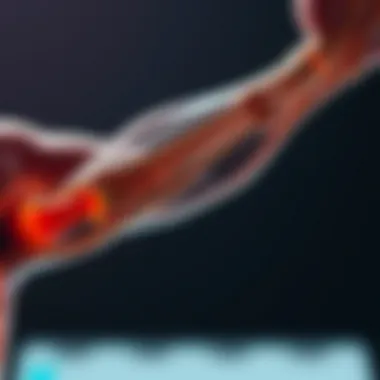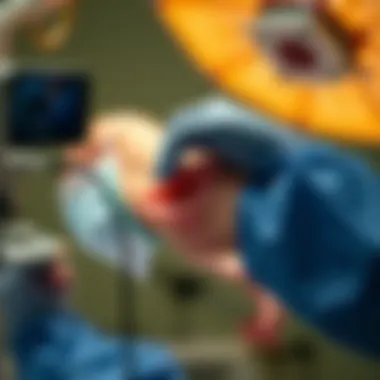Comprehensive Guide to Biceps Tendon Rupture Treatment


Intro
Understanding the complexities surrounding biceps tendon ruptures is vital for both healthcare professionals and individuals seeking knowledge about orthopedic injuries. As we delve into the intricacies of this condition, it's critical to appreciate its impact not only on the physical body but also on the overall quality of life. By comprehensively examining the anatomy involved, injury mechanisms, and treatment options available, this article aims to shed light on effective strategies for recovery and management.
Detailed analysis will illuminate diagnostic protocols, the spectrum of conservative and surgical interventions, and the essential rehabilitation strategies. Moreover, long-term outcomes will be discussed to provide a holistic view of what individuals can expect after sustaining such a rupture. With this groundwork laid, let's explore the relevance of studying biceps tendon ruptures in more depth.
Preface to Biceps Tendon Ruptures
Biceps tendon ruptures are significant injuries that can impact an individual’s daily activities and overall quality of life. These injuries are not merely vague occurrences but often lead to noticeable disruptions in physical function, primarily because of the biceps muscle's critical role in various movements of the arm and shoulder. Understanding the nuances surrounding these ruptures is essential for anyone involved in health care or involved in sports, as it offers insights into injury mechanisms and treatment protocols that can optimize recovery time.
Understanding the Biceps Anatomy
The biceps brachii, commonly known just as the biceps, consists of two muscle heads: the long head and the short head. These heads work synergistically to allow elbow flexion and forearm supination. They originate from the scapula and insert onto the radius, which makes them pivotal for lifting and pulling activities. Injuries to the biceps tendon can occur at the level of its insertion onto the radius or its origin at the shoulder, leading to different clinical implications.
The long head travels through the shoulder joint and is particularly vulnerable to injuries, as it endures wear and tear over time. Key structures, such as the rotator cuff and surrounding ligaments, provide a supportive network but can also predispose the biceps tendon to ruptures when under excessive strain. Recognizing the anatomy of the biceps gives healthcare practitioners a framework to understand clinical presentations and guide treatment decisions effectively.
Incidence and Demographics
Biceps tendon ruptures are prevalent among athletes and laborers, especially those engaged in heavy lifting or overhead activities. Research indicates that these types of injuries generally occur in individuals between the ages of 40 and 60. Interestingly, men are affected more often than women. Statistics show that approximately 15% of all shoulder injuries involve the biceps tendon, suggesting a substantial necessity for awareness in clinical settings.
From a demographic perspective, those who indulge in sports like bodybuilding, tennis, and baseball are particularly at risk. A study found that around 25% of biceps tendon ruptures occurred in weekend warriors participating in recreational sports. This highlights the need for tailored rehabilitation programs that specifically address the biomechanics involved in these activities, ensuring a more focused approach to recovery and reintegration.
Causes of Ruptures
Several factors contribute to biceps tendon ruptures, ranging from acute injuries to chronic degeneration. Common causes include:
- Trauma: A sudden, forceful injury due to falls or accidents can lead to complete tears.
- Overuse: Repetitive overhead activities can gradually weaken the tendon, culminating in a rupture over time.
- Aging: Natural degeneration occurs as people age, leading to a higher likelihood of tears in older adults.
- Underlying Conditions: Conditions such as rotator cuff tears or arthritis can place additional stress on the biceps tendon, making it more susceptible to injury.
Understanding these causes provides invaluable insights for prevention and treatment. An emphasis on ergonomic strategies, conditioning, and strength training can vastly reduce the risk of sustaining such injuries.
"Tendon health is not just about avoiding injury; it's also about understanding the stresses we place on our bodies during daily and athletic activities."
In summary, the significance of comprehending biceps tendon ruptures extends beyond mere statistics or academic discourse. It encapsulates not just the injury itself but the broader implications on physical health, mobility, and life quality.
Clinical Presentation
Understanding the clinical presentation of biceps tendon ruptures is pivotal for prompt diagnosis and effective management. The presentation of symptoms and the physical examination can provide invaluable clues that guide healthcare professionals in confirming a suspected rupture. Focusing on these elements allows for timely intervention, which is crucial to restoring optimal function and minimizing long-term disability.
Symptomatology
When it comes to biceps tendon ruptures, identifying symptoms requires both sharp observation and patient insight. The typical presentation usually includes:
- Sudden, sharp pain in the upper arm or shoulder region: Many patients report feeling like they have been struck, often accompanied by a popping sensation during the injury. This sensation is not just an anecdotal expression; it can serve as a substantial marker in understanding the nature of the injury.
- Swelling and bruising: Following the rupture, blood may accumulate, leading to visible swelling that can vary in severity. Often, patients might experience bruising, especially in cases where there is associated trauma to surrounding structures.
- Weakness and inability to flex the arm: Patients typically face challenges when attempting to lift or rotate their arm. The weakness is usually more pronounced in flexing the elbow, which may limit everyday activities, making even simple tasks difficult. It’s essential to emphasize that the degree of weakness often correlates with the extent of the injury.
- Deformity or abnormal positioning: In some cases, an observable change in the arm’s contour could arise, popularly referred to as the “Popeye deformity.” This occurs when the retracted muscle belly of the biceps moves down toward the lower arm. This visual indication can be a quick red flag for healthcare providers and is a strong indicator for further assessment.
Physical Examination Techniques
The physical examination of a suspected biceps tendon rupture demands a systematic approach to ensure accurate diagnosis. Several key techniques should be applied:


- Inspection: This is a first-pass technique to visually assess the arm for any deformities, swelling, or asymmetry when compared to the other side. Noticing these differences can cue the practitioner to perform a more thorough examination.
- Palpation: Lightly pressing along the biceps tendon to assess for pain or tenderness can reveal a lot. The healthcare provider will feel for any abnormal gaps or swelling along the tendon, which can confirm suspicions of a rupture.
- Range of Motion Testing: Evaluating both active and passive range of motion can provide clinchers on the extent of the injury. The inability to flex the elbow against resistance will often be notable, but a careful assessment of motion can help distinguish between a rupture and other possible injuries.
- Special Tests: Specific maneuvers, such as the Ludington's test, involve palpating the biceps tendon while the patient flexes both elbows. Any discrepancy in tension or pain experienced on one side can indicate a rupture.
The physical exam is not merely a checklist; it’s a dynamic exchange between patient and clinician, guiding a nuanced understanding of the injury's severity.
Being meticulous in both observation and examination fosters the groundwork for appropriate imaging studies and further management decisions. Insights gathered from these steps are essential in crafting effective treatment protocols and maximizing the patient's rehabilitation potential.
For deeper insights into symptoms and examination techniques, exploring sources such as Wikipedia and Mayo Clinic can be beneficial.
Diagnostic Approaches
Diagnostic approaches are crucial in the treatment of biceps tendon ruptures, offering a systematic framework for identifying and confirming the injury. Accurate diagnosis not only informs treatment decisions but also helps set realistic expectations for recovery. The main elements to consider in this realm are imaging modalities and differential diagnosis, which together provide a detailed picture of the injury and its implications.
Imaging Modalities
Ultrasound
Ultrasound is an effective diagnostic tool for evaluating biceps tendon ruptures. One of its significant aspects is its ability to provide real-time imaging, allowing healthcare providers to assess tendon movement and integrity during the examination. This key characteristic makes ultrasound a beneficial choice for assessing soft tissue injuries, given that it avoids exposure to radiation and is more cost-effective than other imaging modalities.
A unique feature of ultrasound is its portability and ease of use, enabling assessments to occur right in the clinician's office during the patient visit. However, its effectiveness can be limited by operator skill and patient anatomy, which may affect the quality of the images. Still, many professionals appreciate the immediate feedback it offers, which aids in timely decision-making regarding treatment options.
Magnetic Resonance Imaging
Magnetic Resonance Imaging (MRI) stands out for its comprehensive detail and visualization capabilities, especially when it comes to soft tissues. One essential aspect of MRI is its ability to provide a clear view of not just the biceps tendon itself, but also surrounding structures, such as muscles and ligaments. This advantage allows physicians to assess any additional injuries that may accompany the tendon rupture, providing a holistic view of the condition.
A notable feature of MRI is its non-invasive nature, and it’s considered a gold standard in diagnosing tendon injuries due to its superior tissue contrast. However, MRI can be more expensive than ultrasound and may not be readily accessible in all clinical settings. The time required to perform an MRI and the need for patients to lie still in a confined space can also be challenges. Despite these drawbacks, the detailed information obtained can significantly improve diagnostic accuracy and guide subsequent treatment plans.
Differential Diagnosis
Understanding differential diagnosis is a pivotal component in the assessment of biceps tendon ruptures. Various conditions can mimic the symptoms of a rupture, such as shoulder strains, rotator cuff tears, or even conditions related to the cervical spine. An accurate differential diagnosis is critical as it directs the clinician toward the most appropriate treatment strategy.
Practitioners usually rely on a combination of clinical history, physical examination, and imaging studies to differentiate biceps tendon ruptures from these other conditions. Careful consideration of the patient's history and presenting symptoms can often provide substantial clues that guide further investigation. Being thorough in differential diagnosis is an essential step to avoid misdiagnosis and ensure that patients receive the proper care they require in their path to recovery.
Treatment Options
When tackling a biceps tendon rupture, identifying effective treatment options is paramount. Therapies range from conservative measures to advanced surgical interventions, all designed to align recovery goals with the patient's lifestyle. Knowing when and how to implement these treatments can significantly impact overall outcomes. This section dives into the various approaches, addressing their merits, potential limitations, and how they can be tailored to individual circumstances.
Conservative Management
Rest and Activity Modification
Rest and activity modification serve as the first line of defense against biceps tendon injuries. This approach underscores the significance of allowing the affected arm to heal by avoiding activities that stress the tendon. The beauty of this method lies in its simplicity and accessibility. Often, all it takes is some time off from strenuous activities, along with smart adjustments in daily routines.
This strategy is beneficial because it minimizes pain and helps prevent further damage. Notably, if the rupture is partial, this conservative management might even allow the tendon to heal naturally over time. However, there lies a unique feature: it necessitates a disciplined approach. Patients must balance their eagerness to return to normal activities with the necessity of healing, which can be a tough nut to crack.
Comparatively, the downside of not adhering to this method could manifest as prolonged pain or the need for more invasive treatment down the line.
Physical Therapy
When the dust settles with initial treatment, physical therapy usually struts onto the scene. This form of rehabilitation is tailored to bolster strength, range of motion, and overall functionality of the impacted arm post-recovery. Engaging with a trained physical therapist who tailors programs to suit the diagnosis is key to its successful implementation.
In many cases, this therapy is considered a popular choice because it actively involves patients in their recovery journey, promoting both empowerment and engagement. The unique characteristic here is the progressive nature of the sessions, starting from gentle movements and advancing to strength-building exercises.


However, it is important to be mindful of potential disadvantages. Without consistent adherence or if the exercises are performed incorrectly, outcomes might not meet expectations. The long-term benefit is clear, but it requires an individual commitment to the program.
Surgical Interventions
When conservative measures fall short or the extent of injury demands, surgical interventions emerge as the next logical step. These procedures aim not only to alleviate pain but also restore the normal function of the biceps tendon. Two primary options come into play in the surgical realm: biceps tenodesis and biceps tendon repair.
Biceps Tenodesis
Biceps tenodesis has gained some traction among orthopedic surgeons as it offers effective results for certain types of ruptures. This surgical option involves detaching the tendon from its original attachment on the shoulder and securing it to another part of the bone. The inherent benefit of this procedure is its ability to relieve pain while preserving function, especially for patients experiencing chronic issues.
The unique factor of biceps tenodesis comes down to its focus on minimizing complications related to the residual tendon itself. However, caution is necessary, as this surgery can lead to specific redundancy issues, where the patient may experience altered biceps appearance or function post-surgery. On the other hand, many find long-term relief, making it a favorable choice for some patients.
Biceps Tendon Repair
Biceps tendon repair is the classic go-to treatment when a complete rupture occurs. The surgeon directly reattaches the ruptured tendon back to its original attachment on the shoulder, making this an appealing option for those seeking to retain as much activity level as possible.
The key aspect of this procedure is its straightforward approach to restoring anatomical alignment, which often facilitates a more natural recovery for athletes or active individuals. However, it does require a significant rehabilitation effort afterward, demanding both time and commitment from the patient. Essentially, while the advantages are evident, so too are the challenges of recovery.
This brings to light the essence of individualized treatment planning. Each option bears its distinct advantages and potential drawbacks, underscoring the importance of comprehensive discussions between the patient and healthcare provider.
"An informed patient is an empowered patient. Choices are many, but understanding their implications makes all the difference."
In summary, successful management of biceps tendon ruptures hinges on recognizing when to opt for conservative approaches or when to turn to surgical solutions. Each path comes with its own set of considerations, making it vital to align treatment with both the nature of the injury and the patient’s long-term goals.
Rehabilitation Protocols
Rehabilitation protocols are integral to the recovery process following a biceps tendon rupture. Proper rehabilitation not only fosters healing but also maximizes the functional outcomes post-injury. The approach must be comprehensive, addressing both physical restoration and psychological support, thus ensuring a well-rounded recovery journey.
Postoperative Care
Postoperative care begins immediately after surgical intervention. The focus during this phase is to manage pain and prevent complications while encouraging initial healing. Instructions from the orthopedic surgeon should be followed meticulously. Some key aspects include:
- Wound Care: Keeping the surgical site clean and dry to avoid infections is crucial. Dressing changes should follow the surgeon's guidelines.
- Pain Management: Appropriate analgesics should be prescribed to alleviate discomfort. It’s important to not let pain dictate activity levels; finding that middle ground is essential.
- Activity Restrictions: Limiting movements that stress the biceps is imperative. Activities that require lifting or overhead motion should be avoided to allow the tendon to heal properly.
- Initial Mobilization: Gentle range of motion exercises may be introduced within the first few weeks, according to the doctor's recommendations. It helps in maintaining joint mobility without overstraining the repaired tendon.
Postoperative care is not just about physical healing; it’s a strategic approach to regain confidence and motivation in your abilities.
Physiotherapy Guidelines
Physiotherapy plays a vital role in restoring strength and function after a biceps tendon rupture. The rehabilitation process generally comprises several phases, with each phase tailored to the healing stage of the individual.
- Early Rehabilitation (Weeks 1-4): The primary goal here is to regain range of motion. The physiotherapist will guide patients through exercises that gently stretch the muscles and tendons without causing undue stress. Light isometric exercises can also be introduced without resistance.
- Intermediate Rehabilitation (Weeks 5-12): As healing progresses, the focus shifts towards enhancing muscle strength. Progressive resistance exercises commence, gradually increasing in intensity. Patients may start engaging in light functional tasks to gradually return to daily activities.
- Advanced Rehabilitation (Weeks 13 and beyond): This phase is about restoring full function and preparing for the return to sports or high-intensity activities. A comprehensive strengthening program is established, focusing on both the biceps and surrounding muscles. Coordination and agility drills may also be integrated to ensure balance.
- Examples include:
- Shoulder flexion in a seated position.
- Gentle elbow flexion and extension.
- Common exercises:
- Resistance band shoulder curls.
- External rotation with light weights.
- Target exercises:


- Push-ups, pull-ups, or overhead lifts as tolerated.
Incorporating specific physiotherapy guidelines tailored to individual needs is vital. Regular assessments by the physiotherapist ensure that the rehabilitation process is proceeding effectively. This leads to informed modifications in the treatment plan, ensuring each individual’s unique recovery needs are addressed.
Outcomes and Prognosis
Understanding the outcomes and prognosis for biceps tendon ruptures is key to tailoring effective treatment plans. This section delves into the various factors that can influence recovery, as well as potential complications that might arise during the healing process.
Factors Influencing Recovery
Recovery from a biceps tendon rupture is not a one-size-fits-all scenario; a multitude of factors can influence individual healing trajectories. Some of the primary considerations include:
- Age: Older patients typically exhibit slower recovery rates compared to younger individuals. The body’s natural healing mechanisms decline with age, making rehabilitation more challenging.
- Type of Injury: Complete ruptures often require surgical intervention, leading to longer recovery times. In contrast, partial tears may heal satisfactorily with conservative treatment.
- Physical Health: Pre-existing conditions, such as diabetes or vascular diseases, can impede healing. A robust cardiovascular system typically promotes better blood circulation, which is essential for healing tissues.
- Rehabilitation Commitment: Adherence to a rehabilitation program plays a critical role. Patients who actively engage in physical therapy exercises and follow their prescribed protocols tend to heal faster. As the saying goes, "no pain, no gain" often rings true in rehabilitation settings.
- Lifestyle Choices: Smoking and poor nutrition can significantly hinder recovery. Nicotine restricts blood flow, while a balanced diet rich in proteins and vitamins supports tissue regeneration.
The amalgamation of these elements can paint a clearer picture of individual prognosis, allowing both patients and healthcare providers to set realistic expectations regarding recovery.
Complications and Risks
Even when treatment is effectively managed, there are potential complications associated with biceps tendon ruptures, which are vital to acknowledge:
- Persistent Pain: Some individuals may experience chronic pain despite surgical repair. This can result from nerve irritation or scar tissue formation, leading to discomfort during regular activities.
- Reduced Range of Motion: Mobility may not fully return, particularly in cases where rehabilitation protocols are not followed meticulously. Limited motion can have downstream effects on overall shoulder function.
- Re-tear Risks: Surgical repairs can fail or, at times, the tendon can re-rupture due to excessive strain. Engaging in high-demand sports without adequate conditioning may place undue stress on the mended tendon.
- Infection: Surgical intervention carries the inherent risk of infection. Proper wound care and adherence to postoperative instructions are crucial in mitigating this risk.
- Shoulder Involvement: Since the biceps tendon is closely linked to shoulder stability, complications might affect the overall integrity of shoulder mechanics, leading to additional issues such as impingement or rotator cuff injuries.
A proactive approach combined with informed decision-making lays the groundwork for optimal recovery.
Epilogue
In wrapping up the discussion on biceps tendon rupture treatment, it's clear that understanding this topic blends science with practical healthcare applications. The takeaways from this article shed light on the complexity surrounding biceps tendon injuries, emphasizing both the anatomical insights and the implications for treatment.
This exploration has focused on various elements, such as:
- The anatomical structure of the biceps and how its functionality is crucial for daily activities.
- The diverse classification of injuries, which ultimately dictates the treatment approaches.
- Conservative and surgical intervention strategies, ensuring tailored solutions based on individual patient conditions.
- The vital role of rehabilitation protocols post-treatment, which are indispensable in promoting optimal recovery.
Realizing that not all biceps tendon ruptures are the same is paramount. Every patient brings their own unique challenges and recovery path linked with factors like age, activity level, and even pre-existing conditions. Thus, a combined approach of surgical and nonsurgical management can be required for optimal healing.
Moreover, the successes and failures in treatments hinge not just on the technique employed, but also wider considerations such as patient compliance with rehabilitation. Emphasizing education and active participation can make a profound difference in outcomes.
“A knowledgeable patient is an empowered patient.”
Recognizing these aspects aids healthcare professionals in developing effective recovery plans while educating patients on both expectations and responsibilities. The journey doesn’t end with treatment; the importance of continuous research and advancements in this field can lead to improved techniques and innovations that could change the standard of care.
Summary of Key Insights
The investigation into the biceps tendon rupture incites various important insights:
- Knowledge of the biceps anatomy is essential for effective diagnosis and treatment.
- Both conservative and surgical options should be thoroughly discussed with patients.
- Rehabilitation plays an integral role in regaining strength and function post-injury.
Understanding these factors sets the stage for better outcomes, stripping away the complexities often associated with tendon injuries.
Future Directions in Research
Looking ahead, research in the field of biceps tendon treatment should focus on several key areas:
- Innovative surgical techniques: Enhancing outcomes with minimally invasive approaches can be the game changer needed; these procedures might lead to decreased recovery times and improved patient satisfaction.
- Biomechanics of healing: Understanding how biceps tendons heal at a cellular level can allow for more targeted therapy options, potentially mitigating the re-injury rates.
- Personalized medicine: As more research unfolds on genetic factors influencing tendon health, customizing treatments based on individual profiles could become a reality.
- Patient-centered outcomes: Exploring the long-term impact on quality of life through various treatment options can provide a better understanding of which approaches may truly enhance day-to-day functioning for patients.
With these elements on the horizon, the field is ripe for breakthroughs that may not only enhance treatment efficacy but also provide reassurance to those affected by biceps tendon ruptures.















